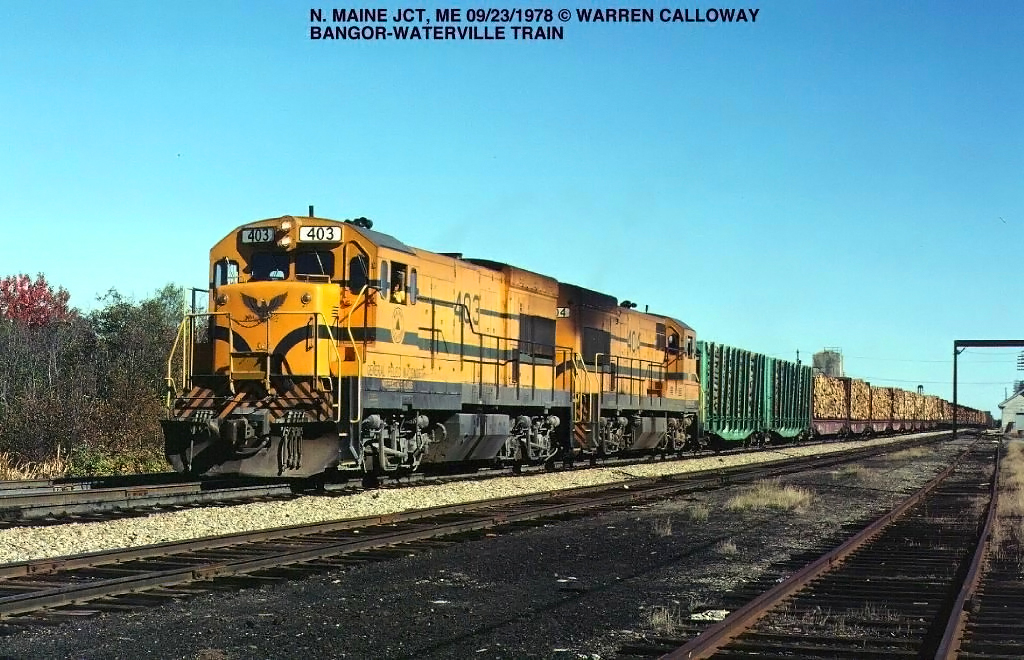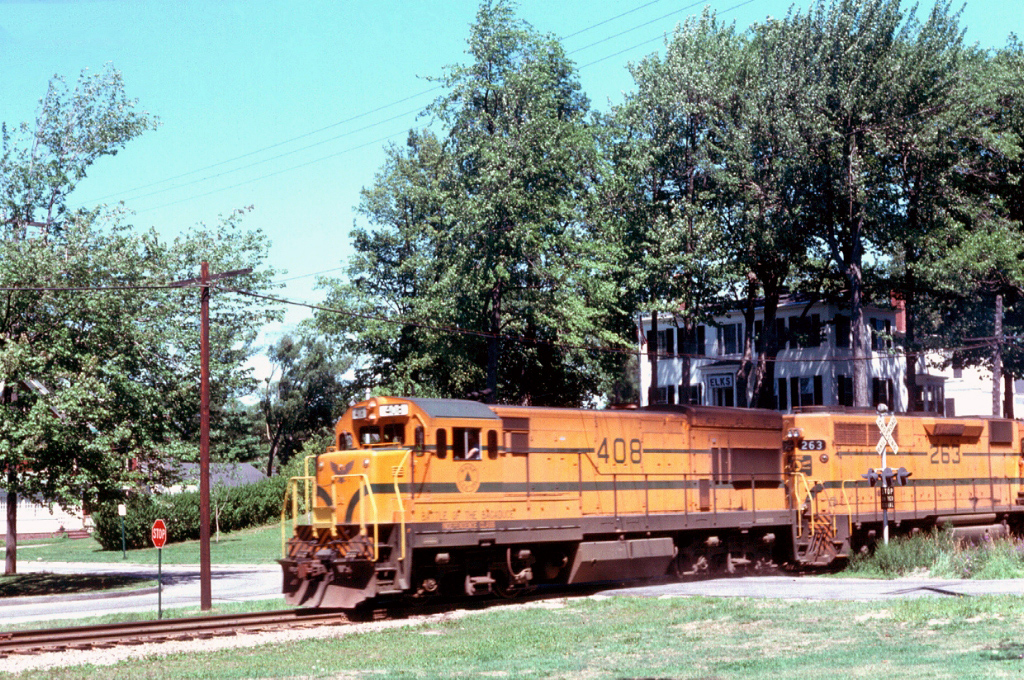GE "U18B" Locomotives: Specs, Roster, History
Last revised: January 2, 2025
By: Adam Burns
The U18B was a late model design the company marketed as a secondary, light branch service locomotive. While GE did sell more than
150 U18Bs, overall it was not extremely successful.
By the 1970s, railroads had lost interest in specialized, non-switcher designs. To make matters worse, the U18B drew complaints of being under-powered and suffering reliability issues.
In addition, crews stated the locomotive featured a notoriously rough ride. It was the Seaboard Coast Line that wound up acquiring the most "Baby Boats," purchasing 105 between 1973-1974.
The Maine Central picked up 10, the Providence & Worcester a single unit, and Texas Utilities two units.
Interestingly, Mexico's large Ferrocarriles Nacionales de México (NdeM) also acquired a large batch of 45 units. Today, you can still find a handful in operation in the United States, notably at short line Pickens Railway in South Carolina.
Photos
 Maine Central U18Bs #403 and #404 are seen here in service at Northern Maine Junction on September 23, 1978. Warren Calloway photo.
Maine Central U18Bs #403 and #404 are seen here in service at Northern Maine Junction on September 23, 1978. Warren Calloway photo.Overview
The U18B was a late addition to the Universal line, beginning production in March, 1973. It was equipped with GE's standard 4-cycle, 7FDL prime mover that could produce 1,800 horsepower.
The Maine Central was not the largest buyer of the U18B but its fleet was particularly interesting. As Brian Solomon notes in his book, "GE Locomotives," the railroad acquired the model to replace its old Alco road-switchers (RS2, RS3, and RS11).
Since the locomotives were completed just prior to the nation's Bicentennial (1976) they were listed as part of MEC's "Independence Class."
The units were painted in yellow paint with green pinstriping and featured a massive eagle adorning the nose. In addition, the railroad named each unit after a notable person or location involved in the Revolutionary War.
The MEC primarily assigned its U18B's to the legendary Mountain Division between Portland, Maine and St. Johnsbury, Vermont.
The remained in use for more than 25 years and some even made it into successor Guilford paint, as illustrated in the above photo.
General Electric offered the U18B with either General Steel Castings' (GSC) swing bolster, drop-side equalizer (AAR Type B) or GE's own FB2 trucks.
In addition, Seaboard Coast Line had units #325-392 equipped with refurbished Blomberg trucks from trade-in EMD units.
Data Sheet and Specifications
| Entered Production | 12/1973 (Seaboard Coast Line #250) |
| Years Produced | 12/1973 - 10/1976 |
| GE Class | U18B |
| Engine | 7FDL (8 cylinder) |
| Engine Builder | General Electric |
| Horsepower | 1800 |
| RPM | 1050 |
| Length | 54' 8" |
| Height (Top Of Rail To Top Of Cab) | 14' 14 1/2" |
| Width | 10' 3" |
| Weight | 220,000 Lbs |
| Fuel Capacity | 1,200 Gallons |
| Air Compressor | 3CDC (Westinghouse) |
| Air Brake Schedule | 26NL (Westinghouse) |
| Trucks | B-B |
| Truck Type | Swing Bolster, Drop-Side Equalizer (GSC) or FB2 (GE) |
| Truck Wheelbase | 9' 3" |
| Wheel Size | 40" |
| Traction Motors | 752-E6 (4), GE |
| Traction Generator | GT581, GE |
| Auxiliary Generator | GY27, GE |
| MU (Multiple-Unit) | Yes |
| Dynamic Brakes | Optional |
| Gear Ratio | 74:18 |
| Tractive Effort (Starting) | 70,000 Lbs |
| Tractive Effort (Continuous) | 57,500 Lbs at 10.7 mph |
| Top Speed | 70 mph |
The SCL was quite fond of the U18B, which replaced its aging fleet of RS2's and RS3's. They were primarily used in branch and light duty service all across the railroad's network.
In addition, three units #390-392, were assigned to phosphate service in Florida according to Greg McDonnell's book, "U-Boats."
Production Roster
| Owner | Road Number | Serial Number | Order Number | Completion Date | Quantity |
|---|---|---|---|---|---|
| Seaboard Coast Line | 300-309 | 38847-38856 | 2801 | 3/1973 - 5/1973 | 10 |
| Seaboard Coast Line | 310-324 | 38857-38871 | 2802 | 3/1973 - 5/1973 | 15 |
| Seaboard Coast Line | 325-343 | 39388-39406 | 2807 | 11/1973 - 12/1973 | 19 |
| Seaboard Coast Line | 250-261 | 39407-39418 | 2807 | 12/1973 | 12 |
| Texas Utilities | 101-102 | 39506-39507 | 2826 | 2/1974 | 2 |
| Ferrocarriles Nacionales de México (NdeM) | 9000-9011 | 39641-39652 | 2810 | 1/1974 - 2/1974 | 12 |
| Ferrocarriles Nacionales de México (NdeM) | 9012-9019 | 39653-39660 | 2810 | 3/1974 - 4/1974 | 7 |
| Ferrocarriles Nacionales de México (NdeM) | 9020-9037 | 39661-39678 | 2810 | 7/1974 - 9/1974 | 18 |
| Ferrocarriles Nacionales de México (NdeM) | 9038-9044 | 39679-39685 | 2810 | 10/1974 | 7 |
| Seaboard Coast Line | 344-392 | 39852-39900 | 2900 | 8/1974 - 11/1974 | 49 |
| Maine Central | 400 ("General Henry Knox") | 40720 | 2824 | 5/1975 | 1 |
| Maine Central | 401 ("Hannah Weston") | 40721 | 2824 | 5/1975 | 1 |
| Maine Central | 402 ("General John Stark") | 40722 | 2824 | 5/1975 | 1 |
| Maine Central | 403 ("Peleg Wadsworth") | 40723 | 2824 | 5/1975 | 1 |
| Maine Central | 404 ("Kenneth Roberts") | 40724 | 2824 | 5/1975 | 1 |
| Maine Central | 405 ("Arundel") | 40725 | 2824 | 6/1975 | 1 |
| Maine Central | 406 ("Colonel John Allan") | 40726 | 2824 | 6/1975 | 1 |
| Maine Central | 407 ("Unity") | 40727 | 2824 | 6/1975 | 1 |
| Maine Central | 408 ("Battle of the Bagaduce") | 40728 | 2824 | 6/1975 | 1 |
| Maine Central | 409 ("Ethan Allen") | 40729 | 2824 | 6/1975 | 1 |
| Providence & Worcester | 1810 | 41482 | 1408-1 | 10/1976 | 1 |
Sources
- Foster, Gerald. A Field Guide To Trains. New York: Houghton Mifflin, 1996.
- McDonnell, Greg. U-boats. Toronto: Stoddart Publishing, 1994.
- Marre, Louis A. and Pinkepank, Jerry A. Contemporary Diesel Spotter's Guide, The: A Comprehensive Reference Manual To Locomotives Since 1972. Milwaukee: Kalmbach Publishing Company, 1989.
- Solomon, Brian. GE Locomotives: 110 Years Of General Electric Motive Power. St. Paul: MBI Publishing, 2003.
 A Maine Central freight, led by U18B #408 (named the "Battle of the Bagaduce"), rolls through Brunswick, Maine during the summer of 1976. Randy Kotuby photo.
A Maine Central freight, led by U18B #408 (named the "Battle of the Bagaduce"), rolls through Brunswick, Maine during the summer of 1976. Randy Kotuby photo.Production on the U18B had ended by October, 1976. Apparently, the unsuccessful nature of the model convinced General Electric to scrap any plans to released a follow-up.
This unit would have been known as the B18-7 as part of the company's new "Dash 7" series (offering new electronics among other features).
Today, again, you can find a handful of U18Bs still in operation on short lines although there are none known to be preserved.
Recent Articles
-
New Jersey - Wine Tasting - Train Rides
Dec 27, 25 09:57 AM
If you're seeking a unique outing or a memorable way to celebrate a special occasion, wine tasting train rides in New Jersey offer an experience unlike any other. -
Missouri - Wine Tasting - Train Rides
Dec 27, 25 09:51 AM
The fusion of scenic vistas, historical charm, and exquisite wines is beautifully encapsulated in Missouri's wine tasting train experiences. -
Minnesota - Wine Tasting - Train Rides
Dec 27, 25 09:48 AM
This article takes you on a journey through Minnesota's wine tasting trains, offering a unique perspective on this novel adventure.



